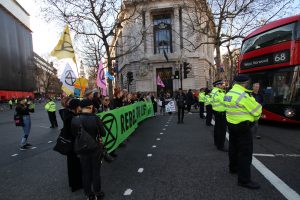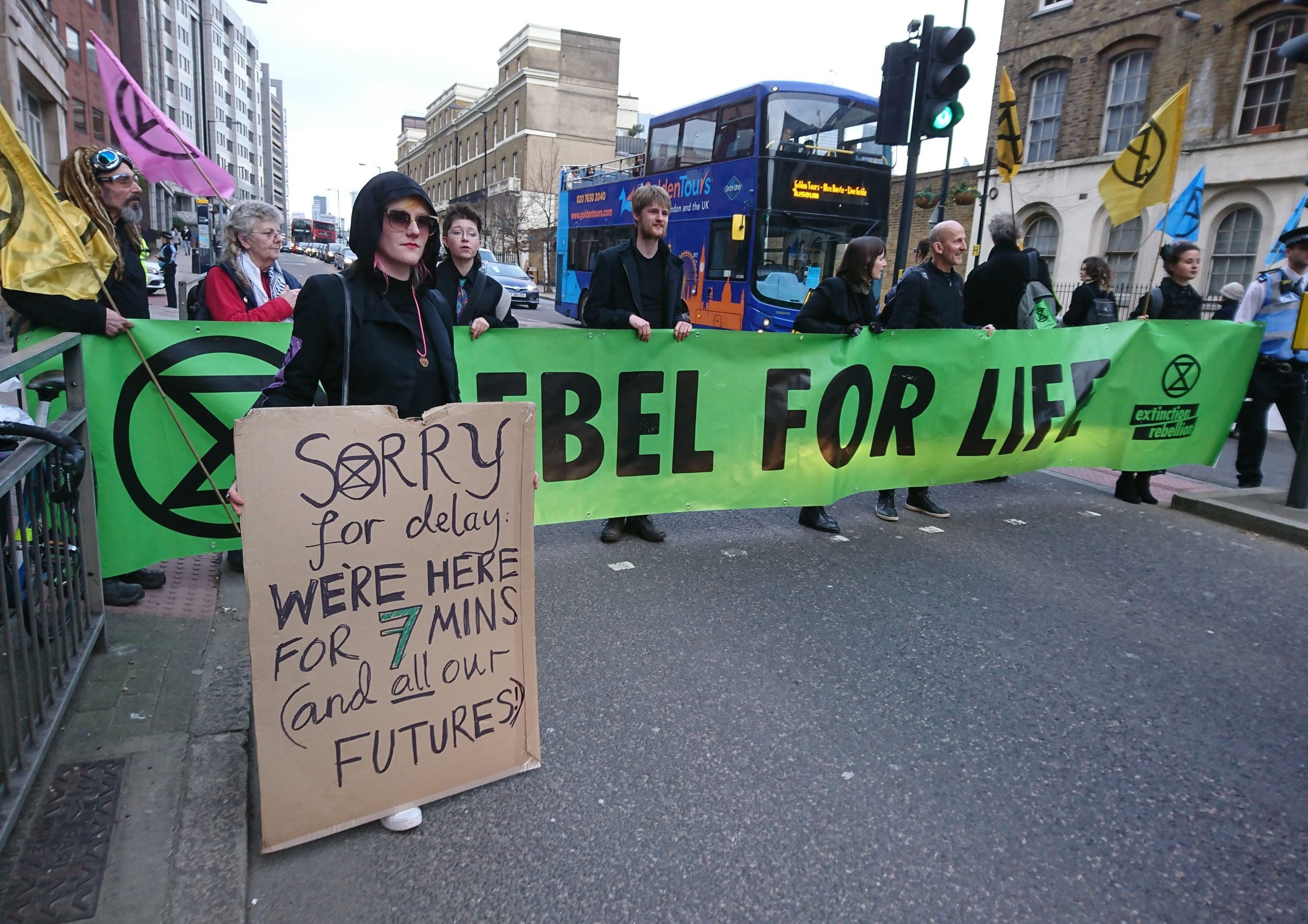It was an unusually warm February’s day in 2019 (in fact, February 2019 was the warmest winter on record here in the UK). It was February 17th, to be exact, and I was dressed in my most fashionable funeral attire I could muster from my wardrobe to attend one of Extinction Rebellion’s early protests outside London Fashion Week…because the Planet is dying, after all.
The plan was to swarm (“Swarming is the tactical – or, in some cases, operational – manoeuvre of converging of highly distributed forces at a single point to leverage the military principle of mass.” – Jeff Vail) the streets surrounding the LFW venues – in an attempt to disrupt traffic, creating gridlock and preventing vital personnel from moving between London Fashion Week venues.
Before we set off to protest, all of us activists were gathered together and given a briefing on how to swarm, how to deal with motorists getting caught up in the blockages, what to do if we were arrested, and a reminder of why we were all there. A bunch of strangers from across the country, gathered together to start making an impact. We all had a role to play, an action to take.
Once we got to our designated intersection, we were allowed to self-organise, to some extent. Activists could choose to hold the banner and stand on the road or hand out flyers to motorists and explain what was happening. Initially, I was one of the sets of hands holding up a florescent green banner with the words “REBEL FOR LIFE” emblazoned across it. I even manned the timer for a time. After each 7-minute swarm, we retreated to the pavement for 3 minutes. During this time, we could rest our arms (holding a banner for 7 minutes is not a position many of our muscles were accustomed to back then…but that has changed for many now), regroup, change up our position in the line, hold a flag…or just be there in solidarity.
After a few “swarms”, it struck me that we were asking motorists to essentially idle for seven minutes. No one from XR had instructed us to ask people to switch off their cars. I brought this realisation up with the activist standing next to me, behind this florescent green banner, as we stood in the middle of a major London road. She suggested I bring it up with our XR team leader in the next break. I did, and our team leader exclaimed, “Absolutely! Please do…and thank you!”

For the rest of the morning, I took it upon myself to transverse the traffic, hand out flyers, explain what was happening and ask motorists – as they wouldn’t be going anywhere for the next 7 minutes – if they would consider switching off their engines. I felt immense pride every time someone obliged my request. If I am honest, the challenge of getting people to turn that key became addictive, and I employed every tactic in my arsenal to get them to submit. Everything from being polite, humour, talking to their wallet and even flirting. I would say that at least 80% of the drivers switched off their engines. Some motorists were curious and willing to take information leaflets; some just wound up their windows as I approached and averted their gaze as if I were begging for a penny. Many accepted what was happening – some even championed what we were doing and thanked me. And then, of course, there were those that became angered and enraged by the inconvenience of it all. The irony is what we were doing was to ensure our future – one that looks alarmingly more inconvenient than being caught up in a traffic jam. It was an interesting observation into human behaviour, that’s for sure.
I got to one car – a shiny blue BMW. Its occupants, picture-perfect stereotypes of the Love Island generation. As I approached the driver’s side with a smile and my rehearsed schpiel, this young muscle-mary of man began swearing at me and protesting his anger at the inconvenience this was causing to his Saturday. There was not going to be reasoning with him, so I shrugged my shoulders and mostly likely muttered something along the lines of “this is nothing” as I walked away and continued my crusade with the rest gridlock.
We continued to “swarm” and protest and shout war cries that echoed through the streets of central London. When the protest came to an end and we all started to disperse – some moved onto other venues and some headed home, myself included. I had had all the excitement an introvert who doesn’t really like crowds could take for one day, but it was exciting and energising – a completely new experience for me and I remember feeling a sense of pride and achievement for taking a stand in what I believe in.

As I sat on the Bakerloo line headed north, I reflected on the successes of the day. But that one encounter – the one with the occupants in the blue BMW – really stuck with me. Not because they were rude and obnoxious… I mean, I live in London; rudeness is just a daily occurrence. What struck me was that this couple clearly understood the physical value of exercise and what they needed to do to make their bodies strong. And yet, they had totally missed the very simple comparison with the Planet. How we take care of it, what we take out from it and how we treat it is the same basic biological principles as taking care of our own bodies. I needed to find a way to explain and express that to those individuals who hadn’t quite managed to connect the dots. I fear there are more than I realise.
Then, as many of my ideas do, visuals started to form and collaboration opportunities presented themselves and the I AM IMPACT Project was born.
Later that year, after deciding sustainability was the career of my future, I enrolled on a masters-level equivalent course to brush up on arguing the business case. 2020 became a year of study, research and writing, and what I realised, was that while sustainability models for business were great…for the corporate world, they did not translate well to conversing with everyday people. Building on this human form is like the Planet analogy, I started explaining the models I found most impactful in a new way. My hope is that looking at sustainability as a single concept, made up of different ‘operating systems’ or ecosystems that are dependent on each other to succeed, rather than looking at the three pillars as separate entities – will give us a fighting chance to understand our impact, and what that means for us in future. I want to restore agency to what often feels like a hopeless world.
